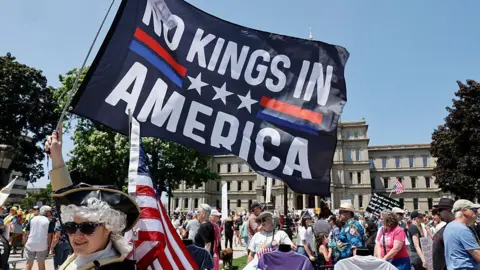In recent days, massive protests erupted across the United States in response to a military parade held by President Donald Trump. The demonstrations, organized under the banner of “No Kings,” were aimed at opposing Trump’s administration and its controversial policies, particularly regarding immigration. The protests spanned numerous cities, including prominent gatherings in places like New York, Philadelphia, and Los Angeles.
On June 14, 2025, coinciding with Trump’s birthday, he presided over a rare military parade in Washington, D.C., intended to commemorate the 250th anniversary of the U.S. Army. This parade drew criticism not only for its perceived extravagance but also for the political implications surrounding it. In the lead-up to the event, Trump issued warnings that protests at the parade would be handled with “heavy force,” a statement that cast a shadow over the celebrations.
The “No Kings” protests emerged as a reaction to Trump’s governance style, which many perceived as overreaching the constitutional limits of presidential power. This movement gained momentum particularly in the wake of ongoing discontent towards Trump’s immigration policies. Organizers claimed that these demonstrations represented hundreds of protest events nationwide, with millions of participants rallying to voice their dissent.
In cities like Philadelphia, demonstrators gathered in central locations such as Love Park. Among the protesters, 61-year-old nurse Karen Van Trieste expressed her desire to “defend our democracy,” highlighting healthcare cuts resulting from Trump’s administration as a significant motivating factor for her involvement. The protests reflected a widespread sentiment among those who feel disenfranchised or endangered by the current political climate.
Los Angeles also served as a focal point for protest activity, marked by heightened tensions due to recent deportation raids and the deployment of the National Guard by Trump, contrary to the wishes of California Governor Gavin Newsom. Protester Jose Azetcla, affiliated with the civil rights organization the Brown Berets, articulated the emotional charged nature of immigration policies, stating, “It’s not harsh, it’s evil. You don’t separate families.” These sentiments widely resonated among the protesters who felt the administration’s policies were detrimental to families and communities.
Incidents of confrontation arose between protesters and law enforcement, with reports of tear gas being used to disperse assembled crowds. Nevertheless, many participants remained peacefully committed to their cause, continuing to march and rally against the administration’s policies.
While the protests symbolized a significant outpouring of resistance against Trump’s presidency, opinion polls indicated that a substantial portion of the American public still supported his immigration policies. According to a CBS/YouGov survey, over half of Americans approved of the president’s stance on deportations. This disconnect between protester sentiments and public opinion underscores the deep divisions present in American society regarding immigration and related issues.
The symbolism of the military parade, featuring thousands of soldiers, tanks, and military vehicles, served to heighten the contrast between military celebration and civil dissent. Observers noted that while the event aimed to unify and signify national pride, its occurrence amid active protests and deployment of troops to quell dissent cast a stark juxtaposition. Security expert Barbara Starr remarked on the polarization during the time, suggesting that it changed the narrative surrounding the parade.
Amid the protests, a significant moment of reflection occurred as veterans attended the military demonstration. Attendees like Melvin Graves, a Vietnam veteran, emphasized the importance of honoring soldiers for their service, asserting that despite the political backdrop, the event was an opportunity to celebrate those who serve in the military. For many veterans, the parade was a long-awaited acknowledgment of their sacrifices, bringing emotions and memories to the forefront.
In summary, the nationwide protests against President Trump’s military parade encapsulated the intense political and social divisions within the United States. This juxtaposition of patriotism and dissent highlights the complexities of contemporary governance and civic response, particularly in light of contentious policies surrounding immigration and executive power. With organized movements like “No Kings,” the American public continues to engage vigorously in the democratic processes, advocating for change in response to policies they believe jeopardize core values, freedoms, and human rights.



